AlexanderL, 25.12.17, 17:50
1977
tinytalk is founded in Vienna, Austria, when Margaux S. and Emile B. quit the Austrian student press market to found their own magazine.
The first 3 personal and privately affordable programmable standalone computers (Apple II, Commodore PET and Tandy/Radio Shack TRS 80) with a built in ASCII keyboard and screen output are launched into the US-American marketplace. The founders of tinytalk are not aware of anything of that.
1978
In February IEN 28 describes IPv2 (Internet Protocol version 2) followed in Juni by IEN 41 describing the first protocol to be called IPv4. Again the TinyTalk company ist not aware and hears nothing.
1979
TinyTalk's networking history starts in 1979 when Emile B. fascinatedly reads an article on the planned introduction of packet switching in Germany, Switzerland, Austria, Portugal, Ireland and Hongkong (called Datex-P and based on CCITT's 1976 X.25 standard and Canadian packet switching equipment).
In Canada DATAPAC is built by Trans-Canada Telephone System on the equivalent standard and Nortel X.25 equipment is successfully exported to Europe and Asia. In the US Compuserve, Tymnet, Datanet 1 and Telenet also use X.25 as their main protocol. Prohibitive costs of equipment and usage in Europe place this technology out of reach and consideration for TinyTalk.
1980
Emile B. spends a year in France. He practically forgets about networking und publishing and starts to paint, play the guitar, travel and just feed the kids until peace is achieved.
 Own Work - PD - Train station of the small Ch’ti town where tinytalk is located for a year
Own Work - PD - Train station of the small Ch’ti town where tinytalk is located for a year
Research by David Patterson at UCB (University of California Berkeley) and John Hennessy at SU (Stanford University) promotes RISC (Reduced Instruction Set Computing or rather as Sophie Wilson has it - RIS Complexity) as a new strategy in the design of silicon CPUs (Central Processing Unit) and programming language compilers.
The so-called DIX (Digital, Intel, Xerox) standard for 10 Mbit/s "Thick" Ethernet is published as "The Ethernet, A Local Area Network. Data Link Layer and Physical Layer Specifications". Its influence as the enabler of accessible, affordable and well performing networks can hardly be overestimated.
IBM (International Business Machines) selects a combination of Microsoft's Versions of BASIC (Beginner's All Purpose Symbolic Instruction Code) and 8086 DOS (Disc Operating System) as the cheapest and primary of 3 operating packages offered for its planned PC (Personal Computer). Contrary to myth and the impression most PC-history-books give, the 2nd one is Digital Research's CP/M 86 which is very similar to IBM-DOS 1.0 but has more features and is a lot more expensive. 3rd in line is UCSD-Pascal which is built around the University of California at San Diego's Virtual Machine.
1981
Emile returns to Austria and he once more takes up publishing. After having concluded that data networks is out of tinytalk's reach he does not perceive anything more of the ongoing data revolution as yet. Instead he is interested in the newly accessible black and white xerographic copier technology.
CSNET (Computer Science Network) is funded by NSF (National Science Foundation) for an initial three-year period and starts to operate in the United States. Its purpose is to extend networking benefits to computer science departments at academic and research institutions that could not be directly connected to the ARPANET (Advanced Research Projects Agency Net), due to funding or authorization limitations.
 PD - Leonard Kleinrock demonstrates the functions of an IMP
PD - Leonard Kleinrock demonstrates the functions of an IMP
In September IPv4 (Internet Protocol version 4) which still routes most Internet traffic today despite ongoing work on IPv6 is described in IETF publication RFC 791, replacing an earlier definition (RFC 760, January 1980).
The Internet Working Group of DARPA (got "Defense" added to its name in 1972) also publishes a plan with a deadline on the beginning of 1983 for the transition of the entire network from NCP (Network Control Program) to the Internet Protocol Suite (TCP/IP - Transport Control Protocol/Internet Protocol), in development since 1974 and already in use in many academic networks.
 Copied manually, content PD - TCP/IP's 4 vs. OSI's 7 layers
Copied manually, content PD - TCP/IP's 4 vs. OSI's 7 layers
TCP/IP divides networking into 4 distinct layers (2 of which are named in the acronym), a concept that had been promoted by some people in the field (notably Hubert Zimmermann and Louis Pouzin in Europe, Jon Postel and Charles Bachman in America) to overcome the diversity of computing hardware and electromagnetic interconnection schemes. It had been reluctantly incorporated into the ongoing IP-work at DARPA (Vint Cerf and Bob Kahn) in 1978. The 7-layer OSI RM on the other hand (Open Systems Interconnection Reference Model, aka the 7-layer OSI burger) is in the works at ISO (International Standardization Organisation) and CCITT but not ready for publication yet.
At UCB, Bill Joy incorporates a newly written implementation of their TCP/IPv4 suite into the next release of that University's version of Unix, named BSD (Berkeley Software Distribution). Unix's name is a pun on the earlier Multiplexed Information and Computing Service timesharing OS. The IBM PC is launched in August.
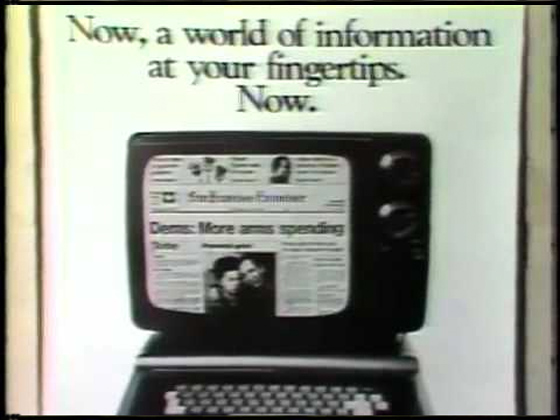 No author found- The San Francisco Examiner CompuServe edition ad.
No author found- The San Francisco Examiner CompuServe edition ad.
Seeing an opportunity to distribute their content online without having to develop their own digital platforms, the San Francisco Chronicle, New York Times, Washington Post, Los Angeles Times, Virginia Pilot and San Francisco Examiner for the first time publish digitally on CompuServe. They had been preceeded by the Columbus Dispatch's text news a year before. Payment is by subscription. TinyTalk's intelligence arm again misses out on these events.
1982
Emile B. helps his father with the public launch of BTX (Bildschirmtext), the Austrian version of Prestel (derived from press telephone and developed at the UK GPO (United Kingdom General Post Office). The event takes place at a West Austrian business fair. The BTX server software on ÖPTV's (Österreichische Post- und Telegraphenverwaltung) data center host in Vienna crashes but the day is saved by friendly colleagues from DP (Deutsche Post) with their host in Berlin to which the Austrian BTX-Team is allowed to connect instead.
 Reinraum - Gemeinfrei - The red piece is the computer and the grey one is the keyboard.
Reinraum - Gemeinfrei - The red piece is the computer and the grey one is the keyboard.
Although ÖPTV even moves ahead to commission the development of a genuine Austrian microcomputer at the Technical University of Graz, called the MUPID, a device that will actually be finished and released into the Austrian and German markets, TinyTalk will never once consider using the technology in earnest due to the ridiculous price-performance ratio of the equipment and subscription, the crippled asymetric networking standard and, we must admit, the initial launch day trauma.
In January Commodore International at the CES (Consumer Electronics Show) in Las Vegas show their Commodore 64, also known as the C=64 or the CBM 64, an 8-bit home computer and the highest selling computer model of all times. It features 64k of main memory, a MOS Technology 6510 CPU, a set of custom chips and lots of interfaces and periphery.
 Blockgraphics galore on Austrian Bildschirmtext
Blockgraphics galore on Austrian Bildschirmtext
And so, as with the BBC in the UK (CEEFAX), in Austria too its Public Broadcasting Corporation enjoys easy and unchallenged success with its purely one way electronic press simulation Teletext, despite loud protest by the print publishers. It would only be in France where the interactive Prestel system, aptly renamed Minitel would have great success by virtue of being coerced onto the population by the French post office and a large amount of subsidies for the mandatory terminal hardware by that stateliest of states.
1983
On January 1st ARPANET and other American scientific research data networks are completely switched over to IPv4 (Internet Protocol version 4) and thus are now universally interconnected. This must be called the real start of the Internet as we know it. Emile learns about this and network layering in general in the reading room of the University of Vienna and is intrigued. 34 years later, in 2017, TCP/IPv4 will still be the most widely used internetworking protocol suite.
In Cambridge, Cambridgeshire, UK, after the unexpected success of their 8-bit BBC Micro (British Broadcasting Corporation micro-computer) manufacturer Acorn Computers develops the ABC (Acorn Business Computer) plan. Acorn's Developers are not satisfied with existing 16- and 32-bit processors. Colleagues Sophie (then Roger) Wilson and Steve Furber read some of the UCB papers on RISC CPU design. They decide to try for themselves and start developing the ARM (Acorn RISC Machine). They already have networking too at Acorn.
As of yet TinyTalk's whole staff still does not learn anything about these important events, although an Austrian is the main investor and CEO of Acorn Computers at the time and another Austrian born guy had been the director of ARPA and had signed the first funding for ARPANET in 1966. Just no mention of it in school or newspapers.
1984
Emile B. privately acquires a C=64 and starts to read more literature on computing, programming and networking. He learns about the existence of Unix, more on networking and inter-networking and other related stuff. He buys newly available books on OS use and computer languages and the related tools and starts to teach himself and the tiny staff the usage of computing machinery, applications and rudimentary software development.
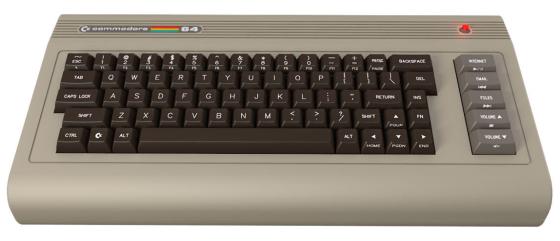 Own work - Public Domain - First computer at TinyTalk, not counting a borrowed Sinclair ZX81
Own work - Public Domain - First computer at TinyTalk, not counting a borrowed Sinclair ZX81
Meanwhile Jack Tramiel, founder and CEO of Commodore International, like so many if not most of the early micro-revolution entrepreneurs had resigned from his own company in January due to internal battles over its future direction. In June, Tramiel arranges a no-cash deal to take over Atari Inc. from Warner Communications and reforms it as the Atari Corporation.
3 years after the Audio-CD Phillips introduces the CD-ROM (Compact Disc - Read Only Memory). In the late ‘80s and early ‘90s, affordable computer CD-ROM drives and authoring software will enable multimedia encyclopedias, games, comics, animated movies, novels, learning materials and reference information on CD, often with hypertext links for navigation. Due to business models some of this content will take long to be taken to the web but after a while many publishers will simply port it over directly. For video and large collections of images, CD-ROMs will remain an important adjunct to the Web throughout its early phase.
Prodigy is the first interactive service a broadcaster undertakes to launch (as a big boys joint venture with PC manufacturer IBM and retailer Sears, Roebuck & Company). In 1986 though, CBS (Columbia Broadcasting System) will leave the venture again when the company decides to divest of the properties that are deemed to be outside its core broadcast business. This is foretelling of how it will fare with broadcasters and interactive networks.
Not yet merged into Boeing, defence and aviation industry contractor McDonnell Douglas for whatever reason buys Tymshare (a computer timesharing company founded in 1964) and in 1989 will sell it to BT (British Telecom). This might mark the first consolidation event where a startup networking company is brought back into the incumbent corporate telecom world.
1985
J.K., a technical consultant on the TinyTalk staff who had always promised to write cute articles on exciting developments in the personal computing world but had always failed to deliver, returns from a trip to the States and brings 5 cheap 300 bits/s modems (real modems, not acoustic couplers) for the C=64 expansion port to the premises. He tries to persuade management to enter the (then practically illegal in Europe) private electronic data communications market on the base and merits of this product.
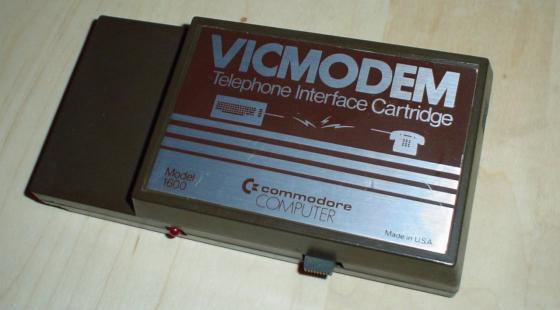 Joe 'Lord Skitch' Jackson - Public Domain - C=64 official modem, TinyTalk owned 2 cheaper clones of this one.
Joe 'Lord Skitch' Jackson - Public Domain - C=64 official modem, TinyTalk owned 2 cheaper clones of this one.
Management refuses to enter the business but keeps one device for experimental secret use. The only financially feasible access point for available C=64 software controlling the modem is an electronic mailbox in Munich. Costs are 8 Austrian shillings per minute. Nevertheless these experiments give first glimpses into cyberspace. Costs are justified by access to 6502 assembly code that used to be manually copied from listings in magazines. Busicalc computations suggest substantial reductions in manpower expenses at Tinytalk plc exceed communications costs hands down. Risk is assessed as minor, a claim that holds, because the criminal prosecution department of the Department of Transportation throughout the 80ies never once catches up with TinyTalk.
 No author found - An ARM2 in an Acorn Archimedes (?)
No author found - An ARM2 in an Acorn Archimedes (?)
The first samples of ARM silicon arrive at Acorn Computers. They work fine and out of the box when first received, installed and tested in April. Later on ARM2s would feature a 32-bit data bus, 26-bit address space and 27 32-bit registers. It has a transistor count of just 30,000 which seems very humble if compared to Motorola's 1979 first 68000 model with around 40,000. It also uses a lot less electric power than other CPUs. With over 100 billion ARM processors produced during the next 32 years, ARM will become the world's most widely used instruction set architecture in terms of quantity produced.
In April Donald C. Latham, ASDC3I (Assistant Secretary of Defence for Command, Control, Communications, and Intelligence), sends a memorandum to the Director of the DCA (Defence Communications Agency) concerning the NRC's (National Research Council) Report on Transport Protocols for DoD (Department of Defence) Data Networks. In it he writes:
"Attached is the final report on Transport Protocols for Department of Defense Data Networks from the National Research Council (Board on Telecommunications and Computer Applications, Commission on Engineering and Technical Systems). The report recommends that DoD immediately adopt the International Standards Organization Transport Protocol (TP-4) and Internetwork Protocol (IP) as a DoD co-standard to the current DoD standard Transmission Control Protocol (TCP) and IP and move ultimately toward exclusive use of TP-4."
The referenced report had also stated that "while TCP currently has the edge in maturity of implementation, TP-4 is gaining rapidly due to the worldwide support for and acceptance of the Open System Interconnection (OSI) international standards."
1986
The Austrian Academic Network (Aconet) is refounded as an asscociation. International connectivity had alread been achieved in 1985 when the Austrian universities had received their first access to international networks like EARN and EUnet via AERN, a node installed at the University of Linz.
The new 56Kbps backbone between NSF centers leads to the creation of a number of regional feeder networks - JVNCNET, NYSERNET, SURANET, SDSCNET and BARRNET - among others. These regional networks build a hub and spoke infrastructure around the NSF backbone, still dominated by large hosts and expensive scientific workstations and terminals. This growth in the number of interconnected networks drives a major network expansion in the professional computing community including DoD, DoE (Department of Energy) and NASA (National Aeronautics and Space Administration). Between the beginning of 1986 and the end of 1987 the number of networks grows from 2,000 to nearly 30,000.
Ethernet is finally winning out over TokenRing and other technologies for connecting computers inside buildings and across campuses. Bridging and routing become ever more important. Companies such as 3Com, Synoptics, Banyan, Cabletron and Cisco emerge with products to feed the "explosion".
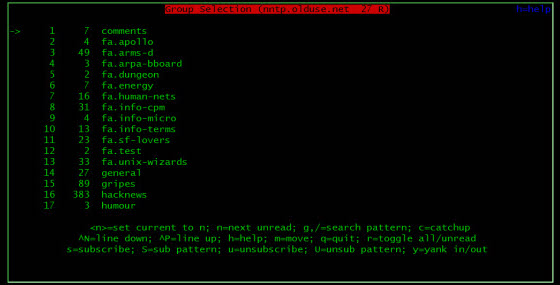
Usenet starts a major shakeup which becomes known as the "Great Renaming". The official reason is said to be the difficulty of maintaining a list of all the existing groups. The main driving force though is that so far most messages are still traveling over ARPANET, where "desirable" news groups such as ‘alt.sex’ and ‘alt.drugs’ are not allowed.
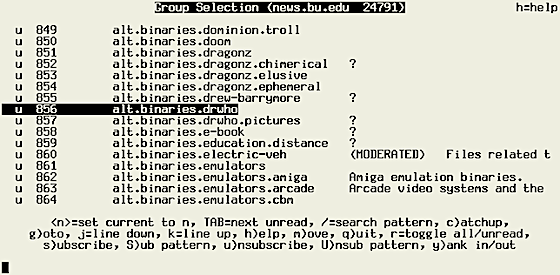
Nothing much concerning this history happens at TinyTalk.
1987
FidoNet reaches Austria. TinyTalk will have to wait for another 2 years to find out about and access it.
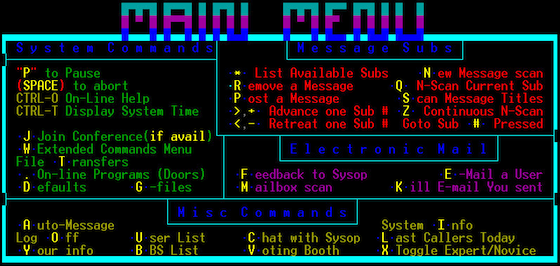 Ctsy of Shannon Matton
Ctsy of Shannon Matton
TinyTalk also gets its first experience with "nice architecture" 32bit machines, in the form of the Motorola 68000 in a used Commodore Amiga 1000 (AmigaOS), quite a bit later to be followed by in '87 still unaffordable Macintoshes (68000, 68030, PowerPC, Mac OS) and even one each of the Atari ST (68000, GEM/TOS), Sega Saturn (Hitachi SH-2, Saturn System) and the Acorn Archimedes (ARM2, RISC OS).
 Commodore Archive - A home computer with a 16/32 bit workstation CPU and a set of custom chips
Commodore Archive - A home computer with a 16/32 bit workstation CPU and a set of custom chips
In June Bob Braden and Jon Postel publish RFC 1009 "Requirements for Internet gateways". In its section B.4. Multi-Protocol Gateways they state, "The present NSF gateway requirements specify only the Internet protocol IP. However, in a few years the Internet will begin a gradual transition to the functionally-equivalent subset of the ISO protocols [17]. In particular, an increasing percentage of the traffic will use the ISO Connectionless Mode Network Service (CLNS, but commonly called "ISO IP") in place of IP. It is expected that the ISO suite will eventually become the dominant one; however, it is also expected that requirements to support Internet IP will continue, perhaps indefinitely.
To support the transition to ISO protocols and the coexistence stage, it is highly desirable that a gateway design provide for future extensions to support more than one protocol simultaneous, and in particular both IP and CLNS [18]."
RFC 985 from 1986 which this one obsoletes did not contain any mention of ISO - OSI.
1988
tinytalk magazine's mother company establishes a computer arm and enters the software development and multimedia content businesses, first in the German and soon in the Austrian marketplace. Specialities of this branch are CBT (computer based training) and POS (point of sales) applications. Data exchange with business partners in the Federal Republic of Germany starts immediately. It is dial-up, cumbersome and pretty expensive thanks to bad European telephone line regulation.
For this venture TinyTalk also gets its first office PCs, IBM PC AT (Advanced Technology) clones, self built with motherboards and other components from the Bavarian Electronics Eldorado in Schillerstraße, Munich. TinyTalk legalizes its Pascal Platform through the acquisition of 5 5.1/4-inch Turbo Pascal floppy discs and also aquires licenses for PLATO, TenCORE and TOPIC to facilitate its early Mixed-Media endeavours.
In August the US NIST (National Institute of Standards and Technology) publishes FIPS 146 (Federal Information Processing Standard concerning GOSIP (Government OSI Profile) and announcing that ISO - OSI protocols must be used in all computers purchased by U.S. government agencies after August 1990.
The Federal Networking Council (FNC), the Internet Activities Board (IAB), and the Internet Engineering Task Force (IETF) together say in RFC1169 they have a firm commitment to responsible integration of OSI based upon sound network planning. Allegedly planning is underway within the Internet community to enable integration of OSI, coexistence of OSI with TCP/IP, and complete interoperability between OSI and TCP/IP. Nothing of this will ever materialize. Instead, 30 years later, IPv6 will still be making snail-like progress across the globe.
 7 layer OSI burger with quantum bottom and human top make 9 layers.
7 layer OSI burger with quantum bottom and human top make 9 layers.
1989
In June, the spread of TCP/IP is fueled considerably when the University of California in Berkeley agrees to place its TCP/IP code developed for BSD UNIX into the public domain. Various corporate vendors, including IBM, included this code in commercial TCP/IP software releases. TinyTalk still has no access to and barely any information about this code and its effects on the further development of global area networking.
CompuServe establish their first access point in Vienna, Austria. TinyTalk buys an account thus enabling commercial store and forward capability for its software arm. Modem speed is now at 1200 bits/s. TinyTalk also uses FidoNet mail and file exchange for the first time. By these 2 factors wide are data transportation costs come down to local access fees (1 Austrian shilling per minute at the time, down from 8) and permant hassle is reduced by the consequent use of store and forward technology.
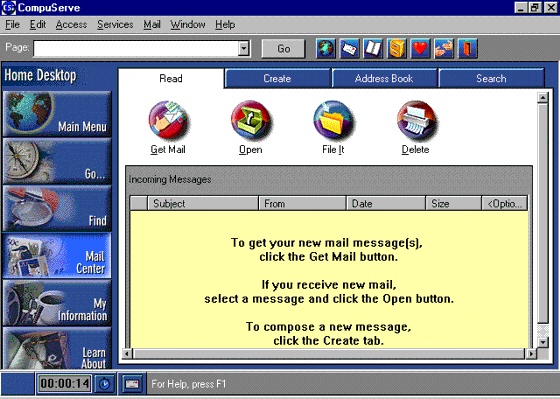 Ctsy of CS archive - CompuServe satisfied TinyTalk's professional data transfer needs for quite a while.
Ctsy of CS archive - CompuServe satisfied TinyTalk's professional data transfer needs for quite a while.
3 articles of TinyTalk's flagship product, tinytalk magazine, are slightly modified in the word processor and get experimentally and electronically posted to the fitting zones of FidoNet and Compuserve. This constitutes the premiere of TinyTalk's online distribution (if you do not count a 1986 publication of a cool piece of code to the MC mailbox). tinytalk is now only 9 years behind the first American publisher to try out electronic publication.
TinyTalk also buys its first "large memory" card for AT clones to be able to test and use Digitalk's Smalltalk/V 286 product thus progressing from OO (object oriented) theory to OO practice. Smalltalk projects can never be sold to customers but inhouse tools are soon all developed with it.
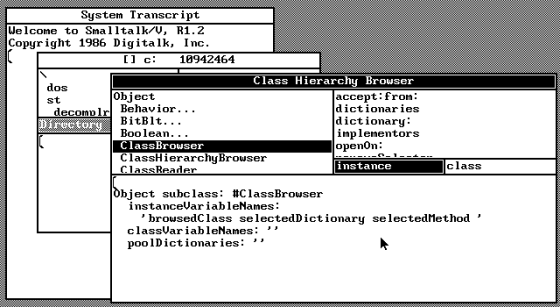 From the Digitalk ST/V Book - That is how TinyTalk learned OO
From the Digitalk ST/V Book - That is how TinyTalk learned OO
In April a first kernel of the future Windows NT OS runs on an emulator or simulator of the Intel i860 at Microsoft. It soon gets ported to the MIPS R3000 and DEC Alpha architectures. Bill Gates' fear of the combination of RISC (Reduced Instruction Set Computing), IP and UNIX, MS's own quite mixed success with that OS, the perceived slowness and bureaucratic hurdles of MS's IBM partnership and the seemingly catastrophic state of Intel's 32bit CISC (Complex Instruction Set Computing) architecture had enabled funding of a potentially risky and secret strategy for a new portable OS.
1990
The computing center of the University of Vienna, gains access to the real Internet via a 64 kbits/s leased line to the famous Geneva-node which on its part is connected to NSFNET, the state sponsored Internet system of the USofA's National Science Foundation. The Vienna-Geneva-US link had in turn been made possible by IBM's EASI Initiative and is fittingly called EASINET (European Academic Supercomputer Initiative Network). Other Austrian universities follow in the same year, only a mere 19 years after the first American universities had joined ARPANET and only 7 years after the switchover to Internet Protocol.
On January 1, 1990 EUnet International Ltd. begins selling Internet access to non-academic customers in the Netherlands, making them one of the first companies to sell Internet access to the general public. Excessive prices keep the service somewhat uncompetitive in TinyTalk's eyes, given its still modest revenue and profit rates.
 No author found - HyperCard "About Birds" stack.
No author found - HyperCard "About Birds" stack.
tinytalk magazine can afford its first Apple PC, a used Macintosh SE/30 that obviously had been bought and quickly been replaced with a completely equipped Macintosh II by its former owner and given away for cheap. Through it TinyTalk had its first glimpse into and experience with Bill Atkinson's HyperCard, the first really successful hypermedia system before Berners-Lee's WWW which most probably also was heavily influenced by it. TinyTalk soon borrows the SE/30 and uses it for prototyping, demos and RAD (rapid application development) of inhouse tools, thus supplementing its internal Smalltalk environment. Its developers have a hyper-easy time with HyperTalk, sometimes quietly and sometimes swearingly building on their former Smalltalk practice. As still no customers want to use large numbers of Apple computers, TinyTalk takes a first look at Asymetrix Toolbook 1.0, a newly released Hypertext-Software for Windows. With a little effort and an available tool existing HyperCard stacks can be ported and transformed into ToolBook books. Opportunity came to TinyTalk's door.
Completely unknown to the TinyTalk staff, while employed at CERN (centre européen de recherche nucléaire) in Geneva English scientist Tim Berners-Lee with help from his colleague and fellow hypertext enthusiast Robert Cailliau publishes a formal proposal to build a "hypertext project" called "WorldWideWeb".
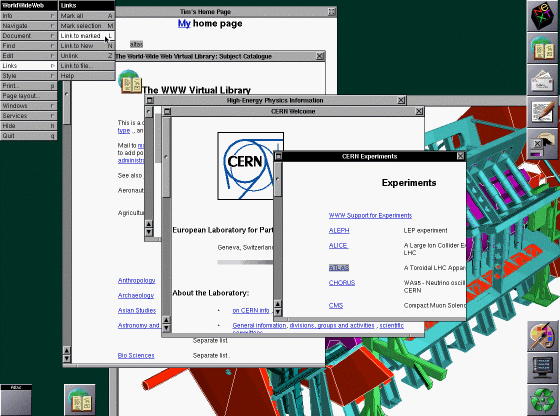 CERN PD - World Wide Web - The world's first HTTP/HTML browser
CERN PD - World Wide Web - The world's first HTTP/HTML browser
Berners-Lee writes and then presents the world's first application to browse the proposed web of documents and the first "web server" to deliver those documents. In the years before Berners-Lee had already thought out URIs (uniform resource identifiers) and URLs (uniform resource locators), HTML (hypertext markup language) and HTTP (hypertext transfer protocol). Both WorldWideWeb (the browser) and CERN httpd (http daemon, the server) run only on NEXTSTEP and NEXT machines, the black cubic luxury computers, courtesy of Steve Jobs and affordable only to "well endowed by the state or rich private sponsors" research institutions.
1991
 SCO's archive probably - SCO XENIX's startup screen
SCO's archive probably - SCO XENIX's startup screen
Only routine stuff happens at TinyTalk. Its employees install cracked copies of SCO's Xenix OS package from 27 floppy discs on one i286 16-bit and one i386 32-bit PC, a Compaq-Deskpro-386-clone, and A/UX on the Macintosh SE/30. Xenix proves to be to cumbersome, expensive to operate and slow for everyday programming jobs and is soon replaced with Coherent on file servers while all 3 workstations revert to DOS and Mac OS.
It is now clear that not only Intel's 16-bit CPUs were flawed but also their 386es cannot compete on the level of 68000s. But the SE/30 also goes back to System 6. Not enough memory for Unix. As TinyTalk's small premises need no routing and "internetworking" data transfer is still exclusively conducted via simple dial-up store and forward from one workstation. Novell's IPX/SPX suite gets rejected and Thin Ethernet and dial-up modems constitute the hardware side of TinyTalk's operations while a mix of protocols from NetBIOS to V.22bis rule data exchange operations. TinyTalk stuff compile and install the academic 7-layer OSI reference implementation and an experimental NetBIOS module for the Coherent File Server.
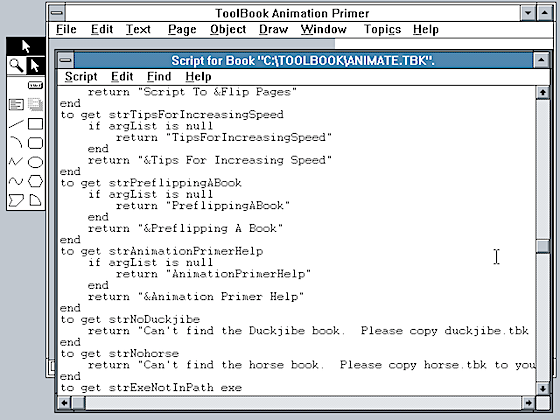 Old screenshot of Toolbook'S scripting editor
Old screenshot of Toolbook'S scripting editor
ToolBook 1.52 and 1.53 get released in quick succession. The TinyTalk software arm has a lot of success by introducing its customers and partners to the joys of hypermedia and providing them with excellent finished stacks, good project workflow and extensive dynamically linked code libraries.
Starting in January CERN's/Berners-Lee's web browser and server are presented and released to the academic world, first at other research institutions, notably at the UIUC's (University of Illinois at Urbana–Champaign) NCSA (National Center for Supercomputing Applications) and the Universities of Innsbruck and North Carolina.
FTP-Server-Administrator Ari Lemmke releases the first version of Linux by Linus Torvalds under a proprietary licence that prohibits commercial usage. It is minimal, unstable (especially its networking-stack) and not even perceived by TinyTalk stuff who prefer Coherent, Minix, DOS, Mac OS, GEM and Windows 386. Real Unixes like SCO Xenix or BSD (Berkeley Software Distribution) are still not practically usable on TinyTalks machines.
1992
2 years after University of Vienna's first connection to the Internet, the whole of ACOnet is switched over to IP, 9 years after Arpanet and 7 years after NSFnet. The switchover is made from X.25 (see above) and made possible by now commercially and affordably available Multiprotocol routers from the US. 3 of them are bought and installed at the Universities of Vienna, Linz and Graz. Other locations are connected to this backbone triangle of main nodes. Connections are leased lines with a capacity of 64 kbit/s or 128 kbit/s. Practically only letters and figures are transmitted.
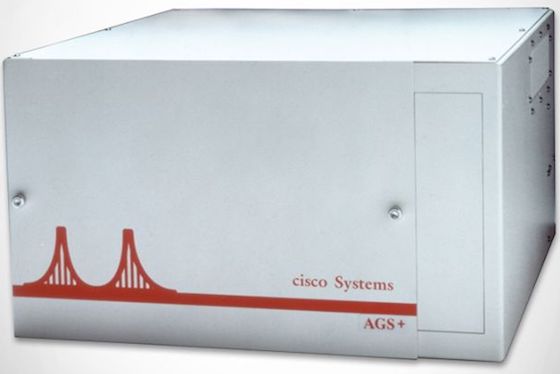 Cisco Archive - AGSes were multiprotocol and once up only went down when uncommissioned. - PD
Cisco Archive - AGSes were multiprotocol and once up only went down when uncommissioned. - PD
While Internet access is still unfeasible for TinyTalk, it always follows its developments by perusal of scientific journals at the library of Vienna University and waits and yearns for a provider to offer cheap and easy entry.
The UUGA (Unix User Group Austria) and a couple of investors found EUnet EDV Dienstleistungs GmbH. EUnet Österreich is the first commercial internet provider in Austria. In April of 1992 their first customer is connected and EUnet Austria becomes the leading internet service provider for Austrias larger and international businesses.
Linux's licence is changed to GNU GPL (Gnu is Not Unix, General Public Licence) to facilitate integration of the Linux kernel with GNU software as Linux by itself is not much more than a Minix inspired kernel with not a lot of use and GNU's extensive software package lacks a free kernel. This combination should go on to put enormous pressure on OS vendors like MS, Sun Microsystems, DEC (Digital Equipment Corporation), IBM and academic endeavours like BSD. The latter group though had worked for a while to free their package from commercially licenced Bell Labs code and release 386BSD aka Jolix via an anonymous FTP server in the same year.
1993
TinyTalk goes bust in one of the world's first major multimedia crisises and is reconstructed after an LBO (leveraged management buyout) by the current owners (see About tinytalk 1.01 and TinyTalk plc). Its financial base is saved by treason. TinyTalk, under protection by Austrian bankruptcy law and the chapter 11 inspired regulations of its new homebase in Jamaica cooperates with arch-enemy International Business Machines and takes part in a large project based on IBM's VisualRexx under OS/2 2.0. The staff learns everything about OS/2's innards and, full of remorse, return to simpler and more stable systems after TinyTalk's financial base is secure once more. TinyTalk though gladly cashes in the larger revenues and profit margins of that old style world. Emile B. leaves the company and StefanL takes over as the new CIS (chief ideologist and salesman).
Windows for Workgroups 3.11 (originally codenamed Snowball) is released in August of 1993 and shipped in November. It supports 32-bit file access, full 32-bit network redirectors, and a 32-bit file cache, shared between them. Apps and APIs are still mostly 16-bit though. WfW 3.11 requires an i386 machine to run and supports NetBIOS and/or SPX/IPX as the routable protocol over Ethernet out of the box. Starting from January of 1994 TinyTalk will switch the bulk of its Intel-based workstations to WfW 3.11, either up from DOS or down from OS/2.
The Motorola based Macintoshes go from standalone and 2-way LocalTalk to EtherTalk via a GatorBox LocalTalk-to-Ethernet bridge. Local file exchange is still conducted via the Coherent server and access to it via one special gateway. Software delivery is still mailbox store and forward dial-up. Stubborn customers even get served by direct V.32bis connections and Japanese fax tech. Modem speeds begin to overtake expensive line-switched Datex-L speeds, still common in old style host to host communications.
UIUC's NCSA releases a quick succession of versions of Mosaic, their own newly crafted web browser, originally written by Marc Andreessen and Eric Bina for X-Windows. While the original CERN browser had been tailored to the NEXT computer, Mosaic is portable and soon comes in X-Windows (v01.a in June), Amiga (in October) and MS-Windows (v1.0 in November) versions. It can also handle inline images, which was not official. But Bina and Andreessen were to impatient to wait for a decision of the issue and expanded html with their own img-Tag implementation.
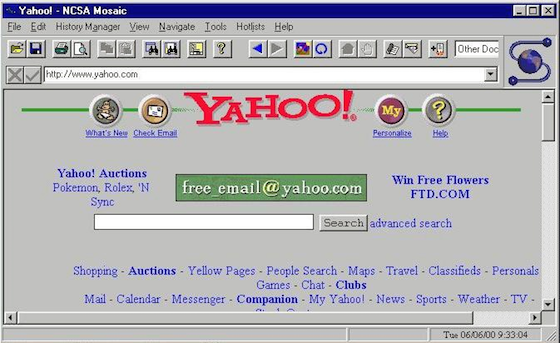 NCSA - PD - That is what Yahoo on Mosaic looked like.
NCSA - PD - That is what Yahoo on Mosaic looked like.
The licensing terms for Mosaic are generous for a proprietary software program. In general, non-commercial use is free of charge for all versions. Additionally, the source code of the X-Windows/Unix version is publicly provided (source code for other versions is available after agreements were signed), but Mosaic is never released as open source software during its brief reign as a major browser.
NetBSD 0.8, the second public BSD variant is released in April followed by FreeBSD 1.0 in November. It will still take some time for these OSes to become completely free of Bell Labs Code. As clients platforms they are usable only for specific task but are the best server systems for smaller and unexpensive computers. They will become rather obsolete on the WWW later on by failing to implement performant and stable JVMs (Java virtual machines when those take over).
In April, CERN announces that the World Wide Web would be free to anyone and with no fees ever due. Two months later the University of Minnesota tells the scientific world that the server implementation of the Gopher protocol is no longer free to use, causing a rapid shift away from Gopher (also of 1991 and which until then had seen a faster takeup) and towards the WorldWideWeb.
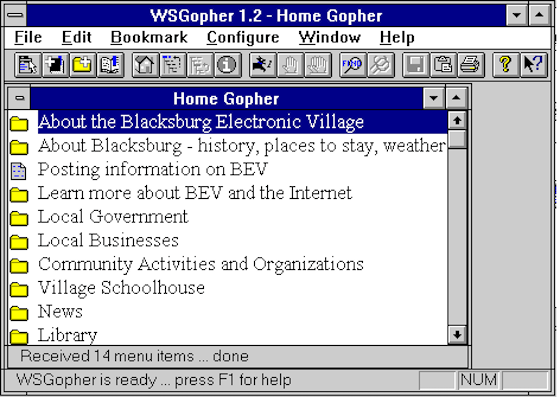 Anonymous author - That is how Gopher looked on Windows.
Anonymous author - That is how Gopher looked on Windows.
Windows NT 3.1, is released in July and named to match the version number of the 16/32-bit WfW product. Its desktop and windows also look the same. It features client and server editions and distributed security in the form of domains. Before the year ends, TinyTalk installs one server with it and conducts tests against Coherent which are promising but not yet conclusive. Compiler tests on a still self-built i386 workstation class machine clearly show it to have a lot more real world stability than OS/2. It contains a Netware SPX/IPX client which is of no use at TinyTalk, but access to the file server is still be possible through a special driver module.
Apple presents the Newton Messagepad, a "personal digital assistant" and the first to feature handwriting recognition by touch. It flops in the market place and its processor is an ARM, later on to famously empower the first iPhone, practically all other "smart" phones and so revolutionize the world of mobile computing.

Blake Patterson from Alexandria, VA - Newton and iPhone: ARM and ARM
CC BY 2.0
1994
After the release of "Mosaic for Windows" word of the WWW spreads fast through all kinds of universities while until then it had been mainly a high class phyiscists' documentation system. Mosauc is freely downloadable from NCSA's FTP-servers and soon many more academic FTP-Servers around the world. All TinyTalk employees become students at Vienna Business University, the first Austrian academic institution to offer easy and free access to the Internet via a large modem-bank for dial-in.
Berners-Lee decides to constitute the World Wide Web Consortium (W3C) to regulate the further development of the many technologies involved (HTTP, HTML etc.) through standardization to avoid divergence as indicated by NCSA's treatment of the img-tag question. He will only partially succeed in this endeavour. Still, this is a big year.
TinyTalk accesses the Internet for the first time through all of its student accounts. Later in the same year ping.at becomes the first Austrian Internet provider to offer cheap dial-in accounts. TinyTalk soon becomes doubly connected, albeit, of course, not permanently but only through tightly controlled and measured time ranges. The split strategy of using commercial private and public services in parallel has been a TinyTalk principle from the beginning and is continued to this day.
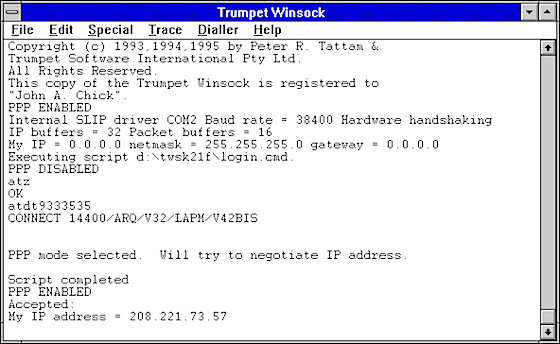 Anonymous author - WinUsers needed a Winsock package to access the Internet.
Anonymous author - WinUsers needed a Winsock package to access the Internet.
A Winsock package is required to support TCP/IP in Windows 3. In August 1994, Microsoft releases Wolverine, a 32-bit TCP/IP stack as an add-on package for WfW3.11. It can be accessed from the usual 16-bit Windows applications via a Winsock thunk. But sadly, Wolverine is of no use to TinyTalk as it lacks dial-up support. Consequently all its i386 and i486 PCs use Trumpet Winsock, a shareware implementation, on Windows 3.x until the arrival of Windows NT 3.51.
Investor and ex SGI founder Jim Clark, looking for new opportunities, finds and recruits lonely Marc Andreessen who, after some quarrel with the University of Illinois' administration had quit his studies and run off to find an investor. First they intend to build an "America first" superior Nintendo competitor. But Clark now finds out about Mosaic and the web, changes horses, talks to Kleiner Perkins Caufield & Byers and with venture money and their own Clark and Andreessen found MCC (Mosaic Communications Corporation).
They recruit other UIUC CS (Computer Science) students from the Mosaic team and release Mosaic Netscape 9.0 in October. Within four months of its release, it had already taken three-quarters of browser installations (it is doubtful to call this a market because only capital and expenses but nearly no revenue is involved because Netscape is eternal testware, free for private use and only sold to companies).
NT 3.5 arrives at TinyTalk and gets installed on the 3.1 server and one workstation. NT needs lots of memory, not a big problem at TinyTalk because of the earlier Smalltalk requirements. Regular "service packing" starts to become common.
 Apple - fair use, The Mac LC tops the Amiga 1000'S design but was probably inspired by it while the Mac II and Amiga 2000 were both downright ugly.
Apple - fair use, The Mac LC tops the Amiga 1000'S design but was probably inspired by it while the Mac II and Amiga 2000 were both downright ugly.
TinyTalk's Mac OS strategy fails finally and formidably and only one Macintosh SE/30 and one Macintosh LC, arguably the prettiest desktop PC ever made, soldier on in the office and do specialized graphics, presentation and print jobs. Usage of of store and forward through billboard systems like Fidonet, Compuserve and FirstClass is continued. EUnet buys a 40% stake in ping.at, marking the start of an extensive strategy to become Austria's major provider not only for large rich international companies but also for SMEs and the audience at large. The strategy will fail later on.
1995
TinyTalk buy their first domain and create first a static homepage and later their first dynamic web offer via CGI and a C++ coded backend. Its adress and name are 2fast4u.com. TinyTalk's core magazine business is rearranged. Print and physical distribution are phased out and magazines are given subdirectories on 2fast4u.com.
TinyTalk also enters a contract with German publisher Burda with the intention to provide a longterm social media strategy, first by a Java- resp. C++ resp. Java-coded chat plugin for then dominant browser Netscape Navigator and sibling competitors Internet Explorer, Spyglass and NCSA Mosaic and promising the development of a virtual 3D-chatting, -shopping and -learning and -partying environment for Burda and partners' soon to be released EOL (Europe Online) online service platform. It registers the now obsolete trademark "Vienna Expert Group" to impress Burda's owner and emerging "digital" management.
The Apache Group release Apache, an extension of NCSA's httpd web server. Like Mosaic and later on Navigator it is perceivably better than what is was derived from. It is quite portable and nicely runs on all kind of unixoids.
MCC's browser is renamed Netscape Navigator. The Netscape brand had been coined by employee Greg Sands. Later it turns out that Cisco Systems had registered a trademark of that name before. Still the Mosaic name is now completely dumped and the company becomes NCC (Netscape Communications Corporation) to avoid trademark ownership problems with NCSA. The Netscape web browser does not use any original NCSA Mosaic code, only know-how, and its internal codename is Mozilla, which stands for "Mosaic killer". A cartoon of a Godzilla-like lizard is drawn for the website and goes well with the company's focus on crushing the competition. In August Netscape makes an extremely successful IPO thus laying the foundation for the dotcom bubble. After some talking with Larry Ellison and Scott McNealy, Clark and Andreessen assert, NNC is a platform now, not just a couple of clients and servers. Gates' holy anger is aroused.
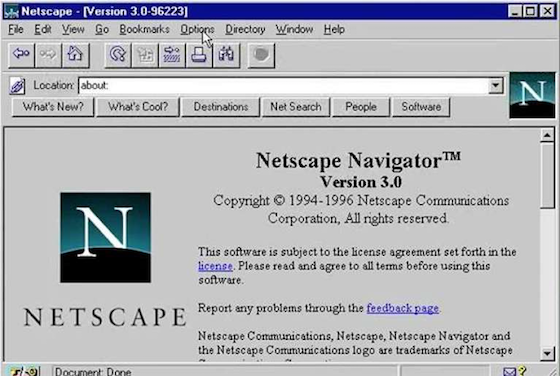 NCC - fair use - Netscape Navigator after a couple of updates
NCC - fair use - Netscape Navigator after a couple of updates
Microsoft releases IE1.0 (Internet Explorer) for Windows 95. IE is not based directly on NCSA Mosaic, as often believed, but on a source licence for the refactored Mosaic code from Spyglass Inc., UIUC's own commercial offshoot created to commercialize and support technologies from NCSA's web and other Internet activities. Microsoft bundles IE with Windows, never charging for it. This period of time becomes known as the browser war years, in which Netscape and MS try everything to outdo and crush each other. In the end MS and Internet Explorer will have the upper hand, as the amount of manpower and capital MS dedicates to the net surpasses the resources available to Netscape's entire business.
So much for the legend, that Gates did not get it with the web. Granted, MS did not twig everything, but they had dug the net if not the web long before that. They had only just accumulated so much legacy by then and the Clark-McNealy-Ellison freebeer plans did not agree well with their principles and business plans.
 Anonymous author - Windows NT was very stable and well documented in the beginning.
Anonymous author - Windows NT was very stable and well documented in the beginning.
NT 3.51 arrives, turns out to be solid and nicely networkable through a feature rich and configurable stack and becomes the standard workstation OS at TinyTalk. Some of the staff shed some tears over WfW 3.11, Mac OS System 7 and Xenix tools. The secretary keeps WfW 3.11, Winsock and the necessary 16-bit applications, external graphics personal continue to work on System 7 on the Macintosh LC and a quite new Quadra 610. Windows 95 is ignored by TinyTalk although many of its customers use it extensively.
1996
All things start to roll. EOL of Luxembourg opens its gateways and access points in February and the first video advertisement is transmitted from 2fast4u.com to TinyTalk chat clients in heavily modified Navigator browsers. Burda is duly impressed and TinyTalk's software arm, now called VEG (Vienna Expert Group) rightfully proud.
In May the second Win NT 4.0 Beta gets installed and receives 1 Mio. DHVs (developer hate volts) in the first week due to its bricolage character. The Win95 desktop, Network Object Linking and Embedding (OLE) and a lot more, seemingly just grappled on top of a new NT 3.6 kernel and HAL (hardware abstraction layer) and shitty drivers from all kinds of manufacturers drive everybody insane. TinyTalk reverts to NT 3.51, deinstalls the release candidate and first release versions and migrates to 4.0 only after the first service pack has been published. It is now a lot more stable albeit never receives the developers' respect of its predecessor. TinyTalk's remaining Coherent server is finally shut down and replaced with an NT 3.51 server. All network protocols but TCP/IP and SMB are removed from the TinyTalk network. Macs become standalone machines. TinyTalk starts to consider NetBSD and FreeBSD for secondary internal server usage.
Sega Virtual Reality is tested and only one member of the team becomes permanently disoriented. Although Sega only had released the arcade version and had cancelled the home console product, experiments with Canadian military visual tech still looks promising. All too early of course, TinyTalk's hopes for a bright role in the soon to be expected Metaverse.
Also in May, after having been alerted to high losses accumulated, ongoing negative cashflow and no expectations of a forseeable or speedy BEP (break even point), Senator Burda removes its support and stake from EOL thus effectively leading to a sudden shutdown and to an end of TinyTalk's lucrative outlooks. Customer IBM though pays its bills and TinyTalk finds itself with no interesting future and well filled bank accounts.
The first employee leaves Austria for the seemingly greener pastures of Federal United Germany and later the state of California which at the time, like in 1941, was on the brink of metamorphosing into the state of craziness.
The core team struggles on and tries to adapt the already accomplished work and codebase for the then popular pre-open-source shareware distribution pattern. 2fast4u.com is reinstalled on a new machine with NetBSD as its OS, NCSA's httpd and the TinyTalk chat server for demonstration. 60-day-no-connection-limit versions of TinyTalk-Chat and refactored Java-plugin clients as well as NS-Api C++ plugins are on offer. Both server and client receive thousands of downloads and 2fast4u.com sees quite an (expensive) amount of traffic, not only on the downloads but also from the "begun as a demo and got hooked by global chatting" phenomenon. Sadly only 1 seemingly large gay community in Hawaii ever proceeds to actually buy the 250cc (250 concurrent connections) version and the 1000seats client license. After a year of struggle shareware marketing of the product is given up, development is frozen and 2fast4u.com given back to its original owner. According to the WHOIS DB it nowadays belongs to one Markus Kröner in Munich, Bavaria. The tech guy in the domain record is Clemens Freiherr Raitz von Frentz in Hamburg, Hamburg. Ha ha ha.
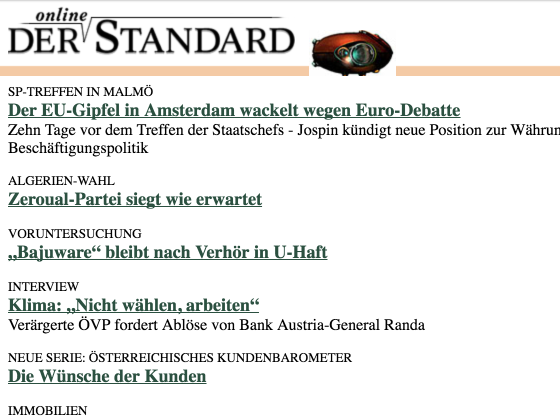 "Der Online Standard" in the Wayback Machine, from '97, but fitting
"Der Online Standard" in the Wayback Machine, from '97, but fitting
In the meantime TinyTalk have received a small consulting commission from the broadcast production and distribution world, and its main server software developer had an offer for a very well paid CTO position from a television hardware- but now would-be software manufacturer. And although newspapers, by virtue of their text and pic oriented software infrastructure, are faster to establish hypermedia news sites on the web, it seems electronic media had woken up too and begin to move just a bit.
A last conjoint effort to adapt advanced OWDBMS (Objects With Dynamic Behaviour Methods and Scripting) technology from the gaming and spying fields of software is wrecked by a quarrel between 2 factions in TinyTalk. Devotees of performance through C++ & LUA argue it out with the fans of even more abstraction with an admiration for new kids on the block Java & Javascript.
In the end server developer ClausS takes the generously endowed CTO position and head of sales StefanL decides to go with HannesW and the JVM+JS route despite of its many disadvantages, one of which is that TinyTalk has to go for Linux, then called the Win95 of the Unix world, and has to relinquish its beloved NetBSD server platform with its still best of the Universe TCP/IP stack but no viable JVM (Java Virtual Machine). After a severe crisis in the mid zero years this will turn out as the right decision.
TinyTalk Workstations will stay on Win NT now for a while as the new client is a stubborn Win NT shop, understandably though, as its early introduction had saved the corporation millions of OS, networking and applications migrations costs.
The End
The rest is 20 years of well known history.
gHack,
25.12.17, 19:55
TT certainly has come a long way... Somehow I still feel privileged to have been able to witness at least the modem age and wider introduction of TCP/IP in German academia.
... plink
|





 Own Work - PD - Train station of the small Ch’ti town where tinytalk is located for a year
Own Work - PD - Train station of the small Ch’ti town where tinytalk is located for a year PD -
PD -  Copied manually, content PD - TCP/IP's 4 vs. OSI's 7 layers
Copied manually, content PD - TCP/IP's 4 vs. OSI's 7 layers No author found- The San Francisco Examiner CompuServe edition ad.
No author found- The San Francisco Examiner CompuServe edition ad. Reinraum - Gemeinfrei - The red piece is the computer and the grey one is the keyboard.
Reinraum - Gemeinfrei - The red piece is the computer and the grey one is the keyboard.
 Blockgraphics galore on Austrian Bildschirmtext
Blockgraphics galore on Austrian Bildschirmtext Own work - Public Domain - First computer at TinyTalk, not counting a borrowed
Own work - Public Domain - First computer at TinyTalk, not counting a borrowed  Joe 'Lord Skitch' Jackson - Public Domain - C=64 official modem, TinyTalk owned 2 cheaper clones of this one.
Joe 'Lord Skitch' Jackson - Public Domain - C=64 official modem, TinyTalk owned 2 cheaper clones of this one. No author found - An ARM2 in an Acorn Archimedes (?)
No author found - An ARM2 in an Acorn Archimedes (?)

 Ctsy of Shannon Matton
Ctsy of Shannon Matton Commodore Archive - A home computer with a 16/32 bit workstation CPU and a set of custom chips
Commodore Archive - A home computer with a 16/32 bit workstation CPU and a set of custom chips 7 layer OSI burger with quantum bottom and human top make 9 layers.
7 layer OSI burger with quantum bottom and human top make 9 layers. Ctsy of CS archive - CompuServe satisfied TinyTalk's professional data transfer needs for quite a while.
Ctsy of CS archive - CompuServe satisfied TinyTalk's professional data transfer needs for quite a while. From the Digitalk ST/V Book - That is how TinyTalk learned OO
From the Digitalk ST/V Book - That is how TinyTalk learned OO No author found - HyperCard "About Birds" stack.
No author found - HyperCard "About Birds" stack. CERN PD - World Wide Web - The world's first HTTP/HTML browser
CERN PD - World Wide Web - The world's first HTTP/HTML browser SCO's archive probably - SCO XENIX's startup screen
SCO's archive probably - SCO XENIX's startup screen Old screenshot of Toolbook'S scripting editor
Old screenshot of Toolbook'S scripting editor Cisco Archive - AGSes were multiprotocol and once up only went down when uncommissioned. - PD
Cisco Archive - AGSes were multiprotocol and once up only went down when uncommissioned. - PD NCSA - PD - That is what Yahoo on Mosaic looked like.
NCSA - PD - That is what Yahoo on Mosaic looked like. Anonymous author - That is how Gopher looked on Windows.
Anonymous author - That is how Gopher looked on Windows.
 Anonymous author - WinUsers needed a Winsock package to access the Internet.
Anonymous author - WinUsers needed a Winsock package to access the Internet. Apple - fair use, The Mac LC tops the Amiga 1000'S design but was probably inspired by it while the Mac II and Amiga 2000 were both downright ugly.
Apple - fair use, The Mac LC tops the Amiga 1000'S design but was probably inspired by it while the Mac II and Amiga 2000 were both downright ugly. NCC - fair use - Netscape Navigator after a couple of updates
NCC - fair use - Netscape Navigator after a couple of updates Anonymous author - Windows NT was very stable and well documented in the beginning.
Anonymous author - Windows NT was very stable and well documented in the beginning. "Der Online Standard" in the Wayback Machine, from '97, but fitting
"Der Online Standard" in the Wayback Machine, from '97, but fitting
...